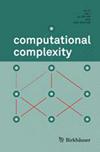电力电路的并行算法与Baumslag群的词问题
IF 1
3区 计算机科学
Q3 COMPUTER SCIENCE, THEORY & METHODS
引用次数: 2
摘要
Myasnikov, Ushakov和Won在2012年引入了功率电路,作为非初等压缩整数的数据结构,支持算术运算加法和$$(x,y) \mapsto x\cdot 2^y$$ (x, y)∑x·2y。同样的作者应用功率电路给出了具有非初等Dehn函数的Baumslag群的词问题的多项式时间解。在这项工作中,我们研究了并行复杂性方面的功率电路和Baumslag群的词问题。特别地,我们建立了可以在NC $$\textemdash$$中解决Baumslag群的词问题-即使其中一个基本步骤是比较由电源电路给出的两个整数,并且通常被证明是P完全的。关键的观察是发生的功率电路的深度是对数的,这样的功率电路可以在NC中进行比较。本文章由计算机程序翻译,如有差异,请以英文原文为准。
Parallel algorithms for power circuits and the word problem of the Baumslag group
Abstract Power circuits have been introduced in 2012 by Myasnikov, Ushakov and Won as a data structure for non-elementarily compressed integers supporting the arithmetic operations addition and $$(x,y) \mapsto x\cdot 2^y$$ ( x , y ) ↦ x · 2 y . The same authors applied power circuits to give a polynomial time solution to the word problem of the Baumslag group, which has a non-elementary Dehn function. In this work, we examine power circuits and the word problem of the Baumslag group under parallel complexity aspects. In particular, we establish that the word problem of the Baumslag group can be solved in NC $$\textemdash$$ — even though one of the essential steps is to compare two integers given by power circuits and this, in general, is shown to be P -complete. The key observation is that the depth of the occurring power circuits is logarithmic and such power circuits can be compared in NC .
求助全文
通过发布文献求助,成功后即可免费获取论文全文。
去求助
来源期刊

Computational Complexity
数学-计算机:理论方法
CiteScore
1.50
自引率
0.00%
发文量
16
审稿时长
>12 weeks
期刊介绍:
computational complexity presents outstanding research in computational complexity. Its subject is at the interface between mathematics and theoretical computer science, with a clear mathematical profile and strictly mathematical format.
The central topics are:
Models of computation, complexity bounds (with particular emphasis on lower bounds), complexity classes, trade-off results
for sequential and parallel computation
for "general" (Boolean) and "structured" computation (e.g. decision trees, arithmetic circuits)
for deterministic, probabilistic, and nondeterministic computation
worst case and average case
Specific areas of concentration include:
Structure of complexity classes (reductions, relativization questions, degrees, derandomization)
Algebraic complexity (bilinear complexity, computations for polynomials, groups, algebras, and representations)
Interactive proofs, pseudorandom generation, and randomness extraction
Complexity issues in:
crytography
learning theory
number theory
logic (complexity of logical theories, cost of decision procedures)
combinatorial optimization and approximate Solutions
distributed computing
property testing.
 求助内容:
求助内容: 应助结果提醒方式:
应助结果提醒方式:


